Dec 22, 2025
Dec 22, 2025
Continued from St. Petersburg, Russia
(An Excursion to the Baltic States and Russia)
We reached Moscow after a short and pleasant flight. Our baggage had taken the longer route by road, and would reach Moscow later in the evening. So we had a lot of time before we checked into our hotel. A pretty young woman with the traditional Russian dress greeted us in the airport along with our Moscow guides. All of us clicked pictures with her until she was so exhausted that she quietly slipped away. We had landed in the smaller airport of Moscow called Sheremetyevo, which is closer to the city compared to the larger Demededovo airport. Our tour bus was waiting for us and we drove to the heart of Moscow to get our first look at the Red Square.
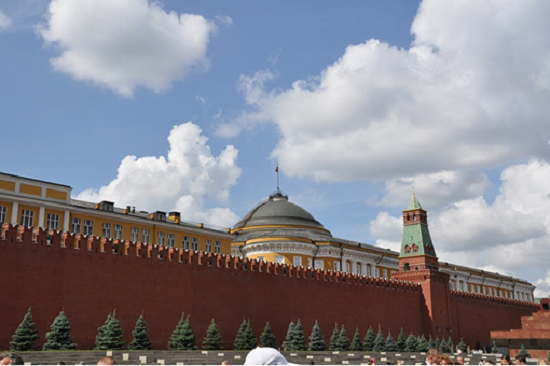
The Kremlin Palace and the wall
We posed for photographs in front of St. Basil’s Cathedral, the symbol of Russia that we see time and again in pictures. The colorful mosaic of its walls and the varying heights of its cupolas made an impression on us. We were to see this landmark of Moscow many times during our four-day stay. We would photograph it in all different lights and at different times of the day and night. We also had a breathtaking view of the Red Square from our hotel room windows. The view was even more spectacular at night when the entire Red Square is illuminated. The Red Square, which actually is a rectangle, was bustling with people at all times. A wall of the Kremlin forms one side of the Red Square, with Vladimir Lenin’s tomb abutting it. Across from it, in a building with ornate front façade, is an upscale mall (called “Gum,” in the local lingo). It sits right across from Lenin’s tomb, and I could not help but wonder how he would react today if he saw a symbol of capitalism, like this mall, raising its “ugly head” in the Red Square.
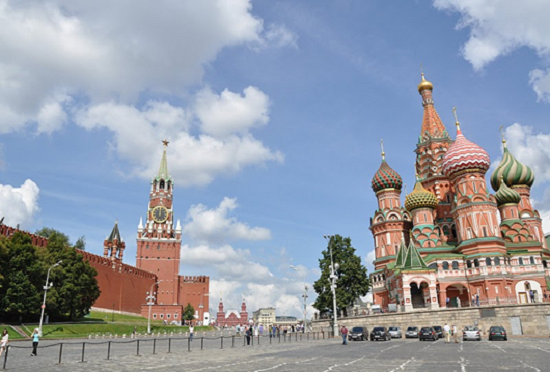
At the entrance to the Red Square: Kremlin is on the left
Across from the cathedral, the historical museum forms the other border of the square. Next to it stands the Voskresensky (Resurrection) Gate and the Kazan Cathedral. Both of these had been destroyed during the Stalin era, in order to expand the gate so that tanks could roll on to the square for the yearly parade, when the communists showed off their wares as a warning to the rest of the world.
The name Red Square has nothing to do with the color of the walls of the Kremlin. Nor does it symbolize communism. It comes from a Russian word that means ‘beautiful.’ The Red Square has an interesting history. The name of Ivan the great from the late 15th century is associated with the beginning of the Kremlin. The term Kremlin means a fort. In the medieval times the area that is the Red Square today was a raucous and rowdy area, where peddlers and drunks hung out. From the time when the Mongols attacked Moscow and burnt it to the ground, the Red Square has had a very checkered history with several conflagrations that razed it to the ground. Only after the 17th century it gained a status as the center of Moscow and Russia. Even Peter the great had supervised executions in the Red Square. (Later we were to see a beautiful painting of angry Peter witnessing an execution in Red Square by artist Vasilli Surikov in the Tretyakov collection.)
However, it was Ivan the terrible, who gave Red Square its most enduring image. He built the St. Basil’s Cathedral in the mid-sixteenth century as a commemorative to the successful conquest of Kazan and the defeat of the Mongols. The cathedral has had other additions later, but its original design is still considered to be an astonishing masterpiece. In front of the cathedral stands the statue of Kuzma Minn and Prince Dimitry Pozharsky, which was erected in 1818. Originally the statue stood in the middle of the square with Pozharsky waving his hand towards the Kremlin, but later was moved to the current spot in order to facilitate the military parades the communists were so fond of. Both these men were important during the war with Polish-Lithuanian Commonwealth in 1612. They gathered a volunteer army that was able to defeat the Polish forces.
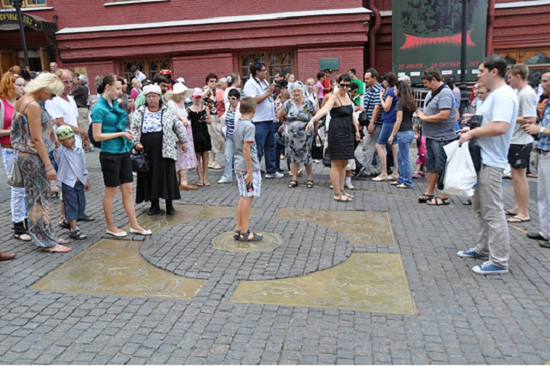
Center of Moscow
We spent an hour or so walking around the crowded Red Square, snapping pictures. We walked through the Resurrection gates to the far side of the square and saw a tile that marked the very center of Moscow. The spot is popular with tourists. They stand on the tile and toss coins over their shoulders. Three or four people, who appeared to be gypsies, were there ready to scramble for the loose change.
Then we got back in the bus to drive to a surprise location for our luncheon. We parked in a small parking lot and then walked below it on a ramp. A small, obscure door was opened and we found ourselves in a large room with a circular seating arrangement with dozens of chairs in a circular pattern. We were told that we were right smack in the meeting room of Stalin’s bunker. Right in the middle of the circle was a tile with a large star, where Stalin had stood lecturing his subordinates. The room reeked with history and I was awestruck. The next room, where there are some memorabilia of Stalin (including his tunic), serves as a restaurant for special occasions, like ours. The food was very good, with a Georgian flavor. More than the taste, it was well presented on tables with rustic appearing wooden furniture and plenty of colorful fruits and decors. Candles lit the tables, and we had a good time not only eating but also snapping pictures, so we could never forget this unique experience.
After lunch, our guide talked to us at length about Joseph Stalin and his lifetimes. I concluded that Stalin had a condition called paranoid schizophrenia. He was suspicious of everyone around him and did not hesitate to deport anyone he perceived as threat to Siberia to do hard labor. There was a painting in his bunker with a story, which our guide elaborated to us. Stalin and a general are shown playing pool. The general is shown with his top collar button undone, while Stalin seems proper with collar tightly wound. When Stalin saw the picture it hurt his ego so much because of his underling general showing insolence with an open collar that he sent both the painter and the general to the gulag in Siberia!
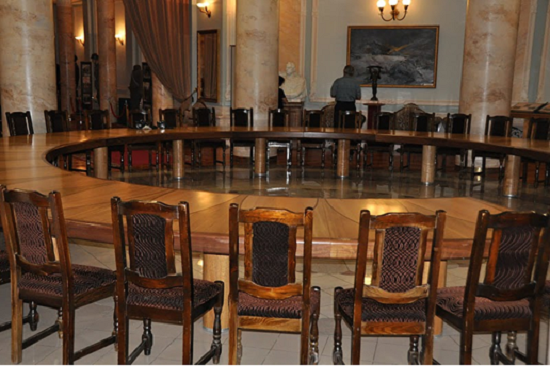
Stalin’s meeting room at his bunker
Stalin had come to power after the death of Lenin in 1924. He has the dubious distinction of even surpassing Hitler in the killing of millions of innocent people. Stalin was in power for 31 years, first as General Secretary of the Communist Party of the Soviet Union and then as the Premier of Soviet Union. After his death in 1953, his successors carried on the same policies until 1991, when the Soviet Empire crumbled, liberating 15 different countries from its grip. During WWII, Stalin aligned himself with the allies in fighting Nazi Germany. Hitler had initially forged a treaty with Stalin with the promise of greater control of Europe along with Germany. But the fact was that Hitler hated the communists as much as he hated the Jews. In breach of its treaty with Russia, Hitler invaded Russia. Nazi army hung around St. Petersburg with a siege that lasted 900 days but it could never take control of the city itself. Eventually, the Nazi army was defeated by the Russian winter (just as Napoleon had been defeated by the weather in Russia) and Hitler suffered his first major defeat.
Stalin industrialized the Soviet Union and with his propaganda machine effectively controlled the information that was purveyed to his people. He was a hero to his people because of his obstinate opposition to America and capitalism. Russian people were kept in the dark as to the clandestine operations and sinister plans to exterminate a large segment of the population, be it political opponents, rich oligarchs or Jews.
Stalin’s death had a ring of paranoia as well. He had suffered a mild stroke and a heart attack during the war. One morning after a long night of dinner and movie he failed to emerge from his room at the usual time. His guards had been under strict instructions not to disturb him at any circumstance. But by that night, some of his subordinates who had come to visit went into his bedroom to find a urine-soaked Stalin lying on the floor uttering unintelligible sounds. Four days later he died and the official cause of death was cerebral hemorrhage.
After Stalin’s death in 1953, his successor Nikita Khrushchev exposed the atrocities committed by their erstwhile leader to the people. His body had been preserved and displayed in a place of respect by the Soviets i.e. in Lenin’s tomb. After the exposé in 1961, his entombed body was brought out of the hallowed hall where Lenin’s embalmed body is still in view, and buried behind the tomb with a statue of his bust to mark his gravesite. Quite a fall from grace for this dictator to be thrown out of the tomb of the father of Russian Revolution and to be buried alongside his subordinate generals, whom he had despised. Though today there is controversy about Stalin among Russian people as to whether he was a tyrant or a capable leader, de-Stalinization has been carried out effectively, I thought. I did not see a single statue of Stalin anywhere in Moscow, other than that of his bust at his gravesite.
Stalin also had a bizarre relationship with his daughter. When she was a young girl she was the apple of his eye. When she turned seventeen, she fell in love and wanted to marry. Stalin disapproved of the marriage and considered her to be ‘impure’ for falling in love with a man (according to our guide). He never talked to her again and Svetlana was never the same again. She had a life full of broken marriages (she was married five times). Finally she moved to the United States and wrote a tell-all book about her father, and now (in her mid eighties) lives in Wisconsin. One of her husbands was an Indian by name Brajesh Singh, who died soon after the marriage. Svetlana got permission to go to India to meet Singh’s family and took part in disseminating his ashes in the River Ganga.
Russians may drink Vodka like water but our group of Indians was faithful to Scotch whiskey. After we checked into the hotel and were amazed at the lovely view of the Red Square and the Kremlin from our windows (Hotel Baltschug Kempinsky). With our customary libations, came the obligatory Indian snacks, which seemed to be in endless supply. We had our singing session and some in our group who had lovely came out of the shell and started singing, which added a lot of fun and novelty to the night. Most people were so full with the snacks that they skipped dinner altogether that night.
Next morning (day 12) we drove to the Tretyakov museum, which houses paintings by Russian artists from 12th century icons to current-day modern paintings. On the way we stopped to see and photograph the Peter Columbus monument. The artist had built this colossal model of a ship, with a larger-than-life sculpture of Columbus as the commander of the ship. He was planning to gift it to the United States but the cost of transporting the artwork turned out to be prohibitive. It ended up finding a place on the banks of Muscovy River with one minor change. Since Columbus had no part in the history of Russia, the artist replaced his head with that of a likeness of Peter the Great. Hence the sculpture earned the name Peter Columbus.
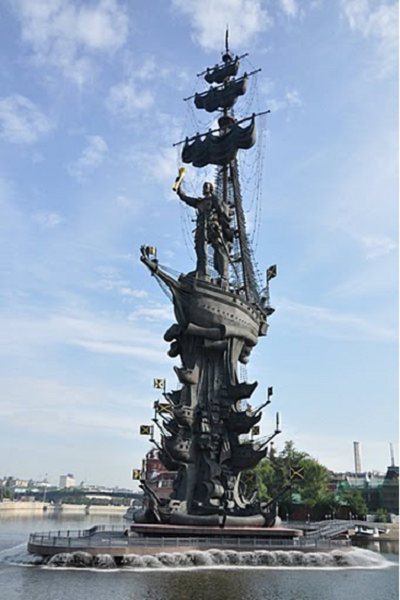
Peter Columbus
Tretyakov was a surprisingly beautiful museum, neither too large nor too small. Icon paintings are painted on wood and mostly deal with Christian religious paintings. Many paintings of Virgin Mary with Jesus in many different poses were interesting to see. The only rule is that all the characters in the paintings should be of those who have attained sainthood. There was also a painting of Ivan the Terrible returning home after winning a war against the Mongol Tartars. In this painting, the rule of sainthood and the Icon paintings was circumvented by drawing a halo around soldiers. Sainthood seemed to have come easily in the old Orthodox Russian church, especially if the Emperor demanded it.
Here are two samples of Icon paintings. Painted on wood, the characters are beatified saints with halo around their heads. In these two examples, virgin Mary is coddling her infant son Jesus.
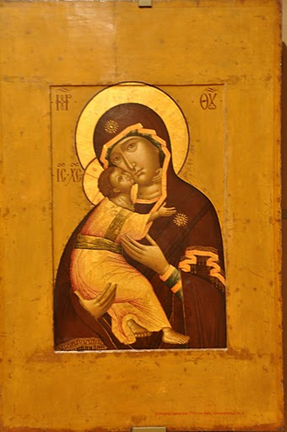
Virgin of Vladimir - 12th century
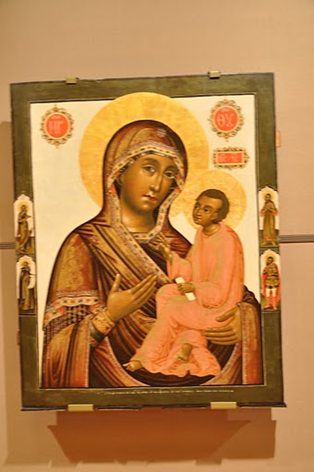
Virgin of Hodegetria - 14th century
We moved on to another part of the museum where 19th century paintings of important painters like Vasilii Surikov and Ilya Repin have their works displayed. A painting of an angry appearing Peter the Great supervising an execution at the Red Square and another of Ivan the Terrible cradling his bloodied son have made lasting impressions on me.
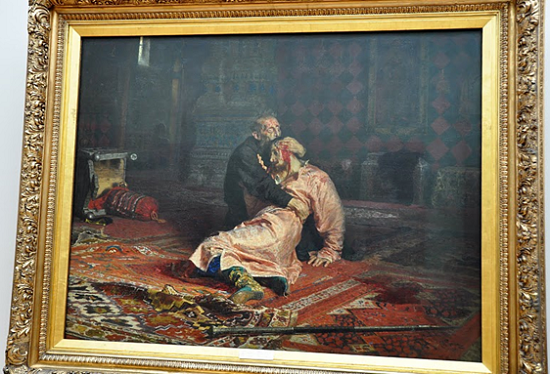
Ivan the terrible with his son after he mortally wounded him
Another painting by Nikolayevich Kramskoy that impressed me was that of a grim-looking Jesus Chist in contemplation sitting in the wilderness. The scene shows a barren landscape with only rocks on which Jesus sits in deep thoughts. The twilight of the setting sun as a backdrop is a powerful metaphor for Jesus’ last day on earth before his crucifixion, when he knew that one of his disciples would betray him and another would deny him.
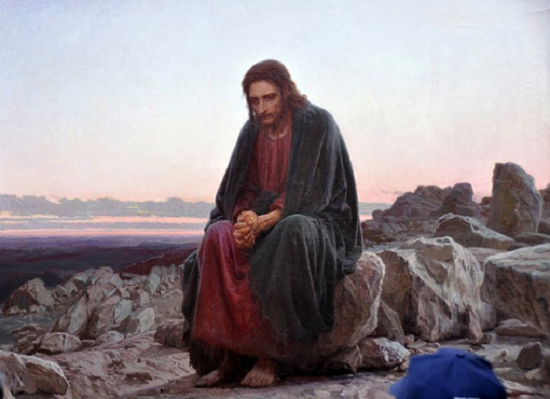
Christ in the Wilderness by Ivan Nikolayevich Kramskoy 1872
After lunch we walked up to one of the gates of the Kremlin. A surprise shower drenched us. We walked past buildings where Lenin and Stalin had lived at the peak of their power. We walked past the Tsar cannon, a massive bronze cannon cast in 1586. The cannon was never used in a war and the exact purpose of it is unknown. Napoleon was impressed by the size of it and wanted to move it to Paris but found it cumbersome to transport such a huge cannon. However, soon Russians defeated his army without firing the cannon. The Tsar cannon weighs close to 40 tons and has a length of about 20 feet
When the showers stopped we walked to the cathedral square in the Kremlin. It is a large square with four cathedrals with golden gilded domes. The Cathedrals of Archangel, Assumption and Annunciation are scattered in the square in a haphazard way. The Ivan the Great Bell Tower is the fourth cathedral with the tallest tower in Moscow (266 meters). The most important cathedral is the Assumption Cathedral where coronation ceremonies of the Tsars took place. It is a relatively small cathedral with a large panel of Icon paintings behind the altar. Some of the seats that the Tsars used are still in view as are the tombstones of bishops and heads of many Russian Orthodox churches. Like the other cathedrals we had seen, this one also had paintings on pillars, walls and the ceiling (no photography allowed).
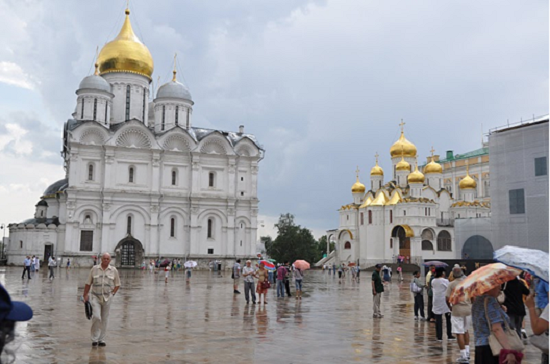
Cathedral of Archangel and Cathedral of Annunciation
Napoleon’s army marched to Moscow to find it deserted because the denizens had been asked to evacuate the city by the Tsar in a strategic move. Napoleon occupied Moscow and used the Assumption cathedral as a stable for his horses. He also left no tile unturned inside the cathedral looking for the fabled treasures (which he never found). Later the Russian army of Tsar Alexander I cut off the supply lines to Napoleon’s army and the onslaught of the brutal Russian winter made Napoleon withdraw in defeat. After the Russian Revolution the cathedral was again neglected in the atheistic world of communism but recently has been renovated to its original glory.
We kept walking along the walls of the Great Kremlin Palace and reached the entrance to the Armour, which is Moscow’s oldest and most prestigious museum. It has a staggering collection of Tsar artifacts. In the lower floor we saw the robes worn by Tsarina Catherine the Great and others during their coronations. Knee length boots worn by Peter the Great (giving proof of his incredible height) and his cane were interesting to see. Many thrones were in display, including the one, which Peter shared with his sick brother Ivan as Co-Tsars. In addition many decorated sleds and state carriages used by the Emperors of the past were neatly lined up in one of the floors. Gold laden harness presented by the Turkish Emperor to Catherine the Great, gorgeous ivory throne with intricate carvings of Ivan the Terrible, the gold and turquoise throne given by the Shah of Persia and many bejeweled crowns were all the highlights.
Many gold ornaments with inlays of precious stones and studded with hundreds of diamonds gave the museum a rich flavor. But the highlights were the gorgeous Faberge Eggs. There are about fifteen intricately carved delicate eggs of the Faberge collection. We could not spend much time in front of the display as a swarm of Chinese tourists (who seemed to be everywhere) nudged us out of there. But in the short time we could spend in front of the window, our guide was able to point out the elegant details of each one of them and their histories.
The opulent lifestyle of the Tsars was plainly visible in the restored palaces and the museums, which displayed their collections. The peasants living in meager existence revoleted in 1905 and again in 1917. Nicholas II had repeatedly ignored the warning signs of uprising by the peasants. Then during the WWI, Russian peasants went through hardships of enormous proportions with all the able bodied young men being sent to the battlefield. Starvation and disease pushed the peasantry to the edge. The Tsar was in the battlefront when the bourgeois revolutionaries attacked the palace in St. Petersburg. When Nicholas II returned to quell the uprising, he too was arrested. The entire family was condemned into exile. A revolutionary government started its rule but soon failed to appease the hungry masses, with inept governance and infighting. Vladimir Lenin and the Bolsheviks stepped in and overthrew the provisional government (1917), thus establishing the Bolshevik government, the Soviet Union. Tsar Nicholas II and his wife Alexandra, along with all their children (four girls and a boy Alexei) were shot to death. The Bolsheviks were not taking any chances with the remote possibility of a Tsar comeback to rule Russia again. Thus the long history of Tsar Emperors of Russia that began with the Rurik Ivan the Terrible in the sixteenth century ended with the Romanov Tsar Nicholas II.
During the twilight of their reign, Nicholas II and his wife were sheltering a terrible secret. Their only son and future heir to the throne, Alexei, was suffering from hemophilia. Alexei’s mother Alexandra was the granddaughter of the British Queen Victoria. She was harboring the gene that caused Hemophilia, which manifested in her son, Alexei. During a crisis when little Alexei was ill with a severe bleeding episode the royal family resorted to the healing powers of a Siberian mystic, Rasputin by name. Rasputin had earned the name “mad monk” both because of his bizarre behavior and his wild eyes with long, unkempt beard. But he did have supernatural healing powers and he reputedly rescued Alexei time and again from the jaws of death. Alexandra’s faith in Rasputin grew to be an obsession, and rumors started around St. Petersburg about an affair between the two. Her letters to him were made public where she professed her love for him and was ready to worship the very ground he walked on. Rasputin himself fanned many of these rumors or did little to quell the rumor of their affair. Rasputin lived a wild life of debauchery, prostitution and inebriation. During his drunken spells he was boasting about his influence with the royals.
A cabal of aristocrats around the Tsar was alarmed with the influence he had over the Tsar and decided to eliminate Rasputin. Earlier, he had survived a stabbing in the abdomen by a crazed woman. Because he survived that severe injury, despite his intestines hanging out, he had developed a reputation as a mad monk who could not die. The aristocrats had planned to kill by feeding him poisoned pastries. But when the poison failed to kill him, he was shot four times and then beaten. Surprised that he would not die, the plotters hastily threw his body into the river hoping he would drown. Two days later when his bullet-ridden body was found he was still barely alive. But he died soon afterwards from the effects of drowning in icy waters, as the autopsy revealed. The legend of Rasputin does not end there. Apparently his body was taken to the nearby woods and cremated. In the middle of his cremation, Rasputin was reputed to have sat up on the pyre, freaking out all the bystanders. Rasputin also had predicted a few days before his own death that the Tsar family would perish soon by execution. He was proven right.
That night our dinner was at the restaurant in the hotel. The food was good and was accompanied by - you guessed it- chilled Vodka shots! We had a good time socializing with each other before retiring for the night. The night view of the Red Square from the window was lovely.
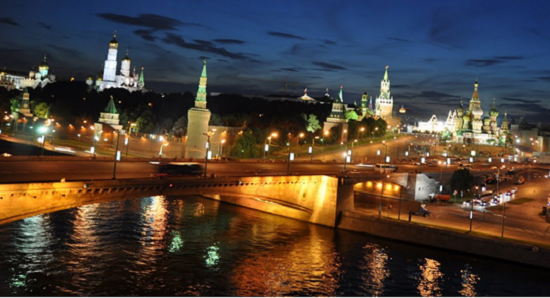
View of the Red Square from our room window at night
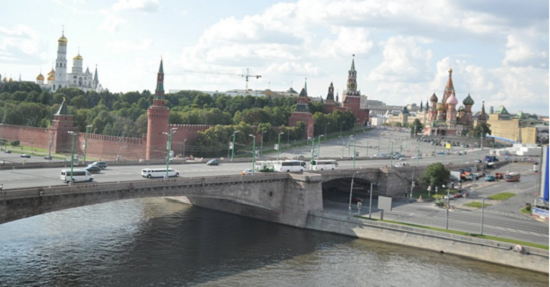
The Same View during the day
During drives towards the periphery of city limits, we had seen blocks and blocks of concrete apartment buildings. These were the apartment buildings the Soviet authorities had loved so much. Even in this concrete jungle, there were different kinds of buildings, our guide Natasha told us. There were the Stalin buildings, which were favored because they were larger and had better facilities. Khrushchev apartments were down to bare bones. Well-connected people were awarded the better Stalin buildings. There was no private property and everyone was forced to live in the apartments, issued by the government. Salary was minimal, but everything was paid for, and after many years the people were able to own the apartments. But the problem arose when the system started siphoning so much money that it was unaffordable for the government to provide the free services. Just like any socialistic government, the quality went down and the access became scarce.
Consequently, there were shortages of basic amenities such as food, clothing and shelter. Food lines in stores just to buy bread were miles long. Everything was rationed. Families with children standing in line got a half a loaf more than others. Natasha told us that when she was a young girl her mother used to drag her out of her bed early in the morning, even in the bitter cold of winter days. This would get the family an extra piece of bread. Natasha turned out to be well sought after because her neighbors would “borrow” her to stand in line with them too, so that they could get an extra ration.
Life became unbearable for people but they had no liberty or political infrastructure where they could protest. This was the setting for Gorbachev to emerge as the leader with his “glasnost” and “perestroika.” The military industrial complex was siphoning all the money. When President Reagan put pressure on the Soviets to compete with Americans in military spending, the Soviets were on the verge of total collapse. There was little choice for the government except to spend more money at the expense of the welfare of the ordinary people. With the society crumbling, Gorbachev’s hands were forced and he reluctantly took path towards reform. Soviet Union was an amalgam of 15 different regions (later countries) and covered 13 different time zones. With the discontent growing among the republics, it was impossible to keep the idea of secession under the wraps. Gorbachev’s reform and openness gave them the platform to organize, and eventually the Soviet Empire crumbled. Fifteen different independent republics were born.
Early morning on Day 13, we attended a lecture by a Russian “diplomat” at the hotel. His name was Sergai (his last name skips my mind but it is not important). We were told that he was an important man in Putin’s government and one could see him in the background in many official pictures. Ten minutes into his talk, where he had injected some jest as well as lightheartedness, I knew he could not mask his true identity. He was an unrepentant, consummate communist, who was nostalgic for the old Soviet era. He addressed Gorbachev and Yeltsin with the unflattering and undiplomatic adjective, “bastards.” He lamented that Moscow is full of billionaires and the gap between the rich and the poor was growing (Moscow has the highest number of billionaires in the world). The diplomat also insinuated that the newly rich people (from the private sector, especially from St. Petersburg) had too much power and were effectively running the show in Moscow. I asked him whether it is true that Mr. Putin was one of the new billionaires, and he sidestepped the question by saying, “Perhaps so” (with a smirk on his face). I also wanted to know as to who was the most popular Soviet leader ever in its history according to the people. He immediately said without hesitation, “Stalin, of course!” Need I say any more?
Vladimir Putin has now become a powerful modern day Tsar. The much anticipated post-communist democracy has faded and the apathetic Russians are not enthusiastic. Now Putin has an ironclad rule in Russia, deliberately not advancing judicial reform and destroying any political opposition with strong-arm techniques of the KGB era (of which he was a colonel). Private businesses have been subdued by the state sponsored harassment. Banking and other financial institutions have been brought under the fold of the government. Putin has enough fodder to practice his crony capitalism, with all the billionaires in Moscow. Dictatorship is well and alive under Putin’s Russia.
After the lecture, we immediately left for a tour of the much- ballyhooed Moscow Metro. Each train station is a work of art. We saw a total of three stations; each had a different charm with artworks and mosaics on the walls. Marble floors, bronze statues and copper inlay work can be seen everywhere. There are large murals depicting some of the history of Moscow. They are very clean and the trains were running at an extraordinary efficiency. In some stations the trains were running very deep in the bowels of the earth, deepest being 276 ft. below ground. It covers close to 200 miles in length and goes up to the city limits. While new stations are still being added, there are already 182 of them. We enjoyed our ride in the trains and they were quite crowded, standing room only.
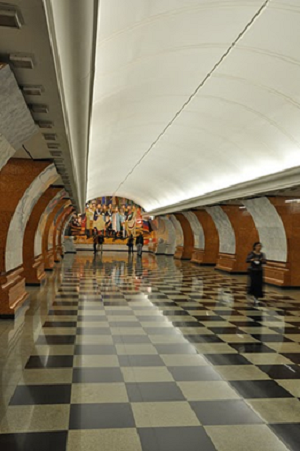
One of the Metro Stations
After we got out of the Metro station we rode to a nice garden called Alexander’s garden, a natural setting with large trees and a large pond. On the other side of the pond was the nunnery called Novodevichy Convent. It is a 16th century monastery that has remained intact over the centuries. Its name can be translated as “New Maidens’ Monastery.” Some famous Russian royal women had been forced into the monastery and forced to take the veil. Peter the Great’s first wife was one such from the royal family. Another was Sophia, the regent of Peter the Great when he was a little boy Emperor (remember Sophia, who used to whisper behind the throne of Peter?). Sadly, she never married and spent the rest of her life incarcerated in the monastery.
Following this we were dropped off at Auerbach Street for shopping. Shops after shops in rows were selling similar wares, mostly trinkets and costume jewelry. Prices were reduced by 50% the moment you walked into the store and then you are free to bargain another 25% discount. Still one would end up spending hundreds of dollars walking out of the stores. There were many restaurants on the street as well. We ate in Hard Rock Café, where the service was at snail’s pace. There were many other American chain restaurants as well. McDonalds is an upscale restaurant here. Then there were Subway, Dunkin Donuts, Sbarro Pizza and, of course, Starbucks. Russians have embraced capitalism and Americans have found willing participants. There are no more bread lines or rationing of food. Food is plentiful but expensive and we saw all restaurants brimming to capacity and doing brisk business. But they are not completely Americanized yet, I thought. I did not see any T-shirt shops or shops selling baseball caps!
I left the shopping to the fair sex and decided to walk back to the hotel in light rain. I walked along two walls of the Kremlin and reached the hotel in about 45 minutes of brisk walking. This was the last night of the tour and we had a farewell dinner at the hotel. It was in a room with that same lovely view of the Red Square. We had good food and wine and we bid adios, promising to see each other again on our next trip.
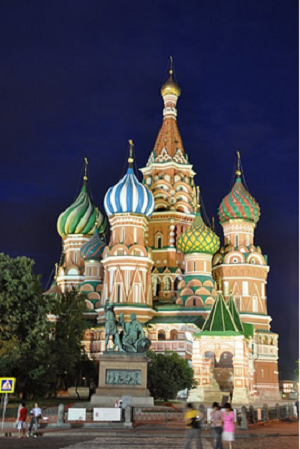
St. Basil’s Cathedral at night
Some of us stayed a day or two more in Moscow. Tauck tours had offered a two-day stay after the tour ended for those who had traveled with them earlier. We made use of the offer and this helped us unwind after the busy trip with many events in the last two weeks. As some in the group started leaving early next morning after breakfast, some of us took the opportunity to see the Pushkin museum. Disappointingly, Pushkin museum was only half open due to renovations but we did see some Rembrandt and Carvaggio paintings. Perhaps the highlight of the museum was the walk we took along the River Moscow, circumventing the Church of Christ the Saviour, which is a beautiful church completely rebuilt after it was destroyed by the Communist regime.
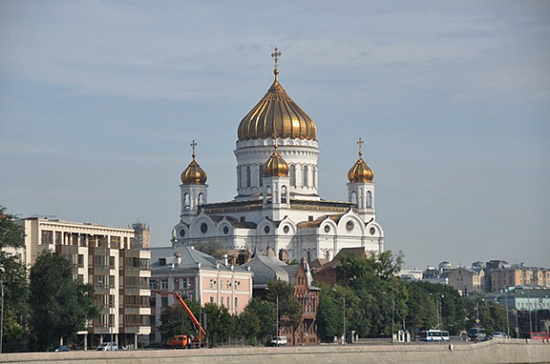
Church of Christ the Saviour
We walked back to the Kremlin and stood in line to pay a visit to Lenin’s tomb. The line was long but it moved fast. No one is allowed to take anything with them, including cell phones or women’s pocket books. Everything needed to be checked in for a few Rubles at a window. As we were entering the tomb, a guard with a serious face was gesturing to everyone to remove their hands from their pockets. No words were spoken and there was pin-drop silence inside the frigid tomb. In the center of the room a young appearing Lenin laid in state under intense lights. Both his hands had been placed carefully on his upper thighs with one of his fists in closed position and the other with an open palm. His face appeared waxy (like what we are used to seeing in wax museum). We were quickly ushered around the body and no one was allowed to linger there.
We also bought tickets to go inside the St. Basil’s Cathedral. The inside of it was in a bit of disarray and it appeared as though some renovation work was in progress. We saw the fairly well decorated room where St. Basil was interred. After climbing narrow winding stairs we were able to go to each one of the cupolas and see it from the inside. There was no artwork and they were all built in plain red brick.
My wife and I went back to Auerbach for more shopping, and then walked back to the hotel. We discovered that instead of going along the outside walls of the Kremlin, we could reach the hotel if we went through the Resurrection gates and walked through the Red Square. That evening we walked to a nice Italian restaurant for dinner. The food was good but the waiters spoke no English. The portions were small (half of what we are served in American restaurants) and the prices were stiff. It was difficult to explain exactly how we needed our food prepared (extra spices, always) but they were not able to comprehend. In the end we just gave up and ate whatever was served. But we were not disappointed.
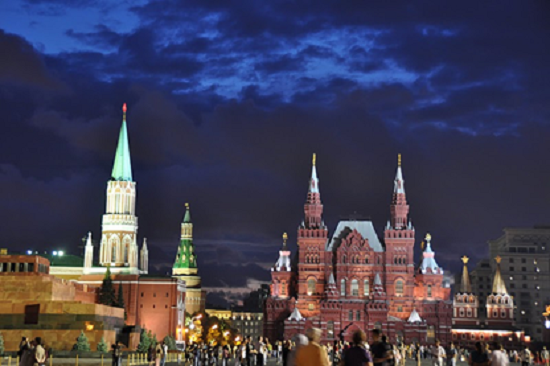
Red Square at night
Next morning we woke at a leisurely pace and walked to the Red Square again. We spent some time picking up more trinkets at the Gum, the upscale shopping mall. We went on a long walk again on the uneven sidewalk avoiding some potholes, realizing that Moscow is not as manicured as St. Petersburg. May be the diplomat was right in saying that the elites from St. Petersburg had more influence in the government than Moscovites. We walked along the bank of Moskva River. At a distance we could see the mammoth building of one of the so-called Seven Sisters. This was one of the seven skyscrapers built during the Stalin era in Russian Baroque and Gothic style. They include Hotels Ukraina and Hilton Leningradskaya, communal apartment complexes of Kotelnicheskaya, high-end apartments of Kudrinskaya Square building, ministry of foreign affairs building, main building of Moscow State University and Red Gates Administrative building.
That evening we gathered in one of our fellow traveler’s rooms (there were only five families left now) for a last hurrah. They had made homemade dishes with their versatile portable stove, and we feasted on them, while singing some more nostalgic songs. We said our final farewells and went back to our rooms to pack our fake Faberge eggs and Babushka dolls for our flight next morning. It turned out that we were the last couple to leave Moscow next day via Sheremetyevo airport. I left Russia with a favorable view of Russians. The common people of Russia had suffered for many centuries. First under the feudal system of Mongols as occupiers, and then under the insensitive Tsar rulers, who were busy amassing wealth on the backs of the poor people. After the so-called people’s revolution their suffering continued under communism and its authoritarian rule for seven decades. They were fed propaganda material during the Cold War by unscrupulous despotic leaders and their minions. But finally they have tasted freedom and gone are the days of imperialism and expansionism. They have to compete in the world stage in the same level field as everyone else. I wish them luck.
Previous Page
12-Oct-2011
More by : Dr. Neria H. Hebbar